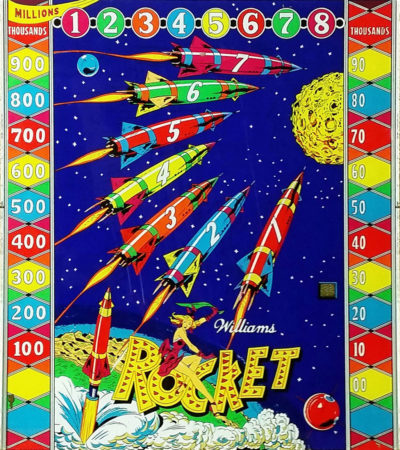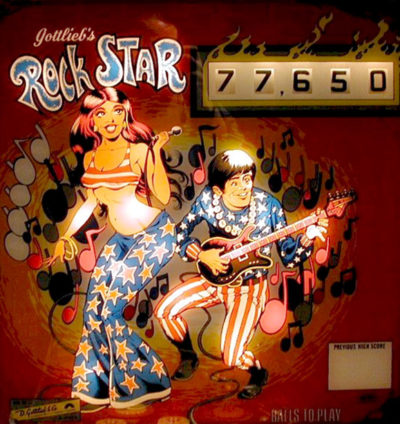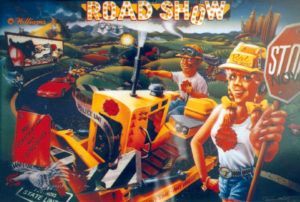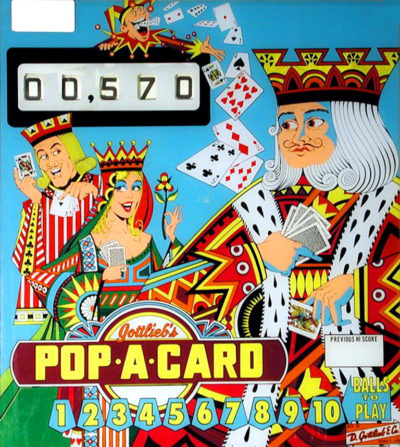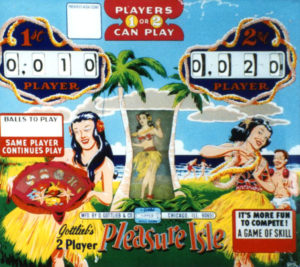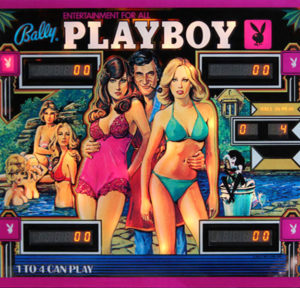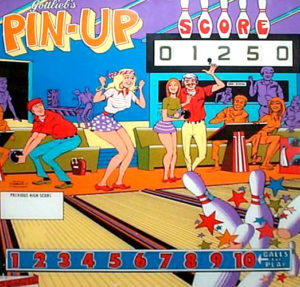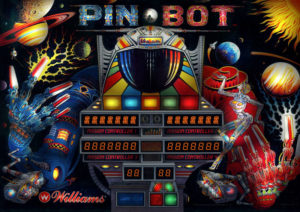-
This unique woodrail game was screwed together in November of the year following the success of a Gottlieb space theme called Rocketship. Harry Williams designed the playfield and game rules while George Molentin inked the artwork. The object of the game is to score at least three rockets on the backglass in order. Doing so awards a replay. This is not an easy task as most of the rockets are “selected” at the top of the machine’s playfield and, even though you may have had a countdown going on a desired numbered rocket to complete this feat, the next ball will most likely change the selected rocket in your countdown sequence! To spot a rocket, you must count down five levels to light the fire bumpers. Hitting one of these spots your actively selected rocket. More replays are yours if you can achieve four, five, six, or seven rockets in order, an extremely rare feat. Score is also another way to score replays. A very challenging playfield for sure, between trying to change your selected rocket and the high-side drain exits take some time to master.The game before you is extremely rare with only 278 screwed together at the Chicago Gottlieb factory. This one-player electromechanical add-a-ball game was designed by John Osbourne with art by Gordon Morison. A replay version was also designed by the name of Blue Note. The object of this machine is to complete all the notes down the left side of the playfield. Doing so activates the classic “wow” feature which, when hit, awards one free ball. A reset is in your future once your current ball drains. Score is another way to achieve longer play by winning extra balls. The spinner in the middle of the playfield awards big points when 1,000 points is lit; each spin of the target awards 1,000 points plus number of revolutions spun. A nice retro art package completes this rare machine.This wide-body mouthful of a game incorporates not one talking head (like in the game “Funhouse”) but two…and they talk to each other during game play. Williams made around six wide-body machines such as this so as to incorporate more real estate space for playfield action and toys. They went by the moniker of the “Super Pin.” This machine was designed by Pat Lawlor and inked by John Youssi. 6,259 were made. In a nutshell, the object of this machine is to cross the US to achieve the ultimate jackpot round. Each time you hit Ted, the day of the week advances in front of him. When you reach Friday, it’s payday. This starts the three-ball multiball series. The jackpot is achieved when you shoot a ball into sleeping Ted’s mouth! Much mayhem, a vibrating motor, two plunger shots, and a lot of characters pop up to taunt you on your way across the country. Country singer Carlene Carter is the voice of Red.This is the next-to-last machine Williams made under the Bally moniker and the first game made to “reinvent” pinball in a last-ditch effort to save Williams from ceasing pinball manufacturing. 6,878 machines were made. George Gomez designed the new platform with Greg Freres and John Youssi designing the art package. This is Star Wars; the last games from Williams were the most technologically advanced games pinball has ever known. The incorporation of a reflecting video monitor with interactive playfield video feedback is revolutionary. The top of the playfield is mostly hidden from view except for a few selectively placed spots which light on occasion. This machine consists of nine different modes which must be conquered to proceed to the ultimate mode, that being the destruction of Mars. A very different game that sold well. However, Williams pulled the plug on pinball and thereafter focused on slot machines.Pro Pool originated in December with 800 units being fabricated. This add-a-ball machine was designed by Ed Krynski with artwork by Gordon Morison. Two replay versions of the game were also made: a two-player version called Big Shot and a four-player version called Hot Shot. Obviously the theme of this game is the game of pool. The playfield is symmetrical and the way to win extra balls is by completing the left and/or right drop target battery. Doing so will lift the left and/or right wow rollovers for this award. The drop targets reset once the sequences are completed. Of course, an operator-adjusted score is another way to score a couple of balls. Back in the ‘70s, multiple balls or replays could be achieved on the game. Today, one free game on a current solid-state game is the common win. Operators have made it harder to achieve free games today as free games yield no income and only result in down time for the machine to earn coins in the till.Gottlieb Pop-A-Card was another classic ‘70s playfield designed by Ed Krynski with artwork by Gordon Morison. Only 825 of these units were made. The replay version of the game was called Drop–A-Card which, as usual, was a much higher produced machine. The open playfield of this game gives ample room for scoring the three banks of drop targets. To win free balls with this game, you have to either complete the 2, 3, 4, and 5 targets, or the 6, 7, 8, and 9 targets…or the 10, J, Q, K, and Ace targets. The first two options light the wow feature to award free balls during that ball in play. If you hit the 10 thru Ace targets to completion, four rollovers light up to score extra balls. Of course, score is another way to score more balls.The last game of ’65 is a two-player add-a-ball game. It was designed by Ed Krynski with art by Roy Parker. A replay model also exists by the name of Paradise. Production run was a meager 265 units; the replay game had 2,100 units fabricated. The animated backglass on this game contains a dancing hula girl. When extra balls are won, they are represented as beach balls on the backglass. If you complete the sequence A, B, C, and D in that order, a free ball is your reward. Roto lights advance and indicate the value of the kickout holes. Points set by the operator award free balls also. An interesting guide rail is on either side of the flipper drains, a variation on a theme. This game is very rare due to its low production numbers.This solid-state game was very popular when it was released and has a lot of smooth shots to complete. It was designed by Jim Patla with artwork by Paul Faris. Production run was 18,250 units. This pre-speaking pinball has Hugh Hefner on its backglass with Bunny Sondra Theodore posing. At the top of the game are four rollover lanes, which advance when hit to a special and advance the bonuses and grotto award. Hitting the five Bunny targets also advance a feature to win extra balls and specials. A unique kickback lane advances with every entrance into it. A five-pack of drop targets also advance certain features on the game. If 20,000 points are made on the bonus system, this point count is carried over to all remaining balls and then some. The nicest shot on the game is going up the right side from the flipper and looping the ball into the grotto. The sound originates from the old TV show “Playboy After Dark.”Gottlieb hatched this add-a-ball machine from the skunkworks in April of the year, designed by Ed Krynski and artwork by Gordon Morison. This single-player machine has a bowling theme and only 715 units were produced at that time. The replay version of the game was called King Pin and many more of these machines were produced. The theme of this game is the drop target completion. By carefully aiming the four inherent flippers on board the playfield, one must try to complete the horizontal row of targets. Doing so will reset the targets and the wow feature activates, giving you a shot at the accomplishment of winning extra balls. Score is another way to pop free balls. The ten drop targets are not so easy to complete and the wow feature advances when you roll over the star rollover. This game is challenging, but a beginner can have ample fun with the machine.This machine was a big hit for Williams with 12,000 machines created. A skill shot starts your adventure with different point values. A three-bank drop target or single right target advances the planets lit in the playfield. If you advance to the lit planet, a free game is your reward. The light grid, if hit when a solo target is lit, opens the visor. Otherwise, hitting all the lights opens the visor. Locking two balls in the “eyes” of the robot starts two-ball multiball. Lock one ball in one eye and shoot for the left solar ramp. Advance the bonus value by making the left ramp loop when the visor is down. This game is fun, challenging and the vocals egg you on throughout your adventure.Official Baseball, Williams #232, 2/60, two players, woodrail with players on the playfield and animated umpire and pitcher, plus a running man unit. Uses 3/4″ balls. Very often the playfield men get broken from the ball play (or the catcher is just plain missing!) A very cool woodrail (maple side rail) baseball arcade game with hole style scoring (opposed to the 1963 and later target scoring scheme), and a very good looking game. Two player game, so competitive play is encouraged. High score is kept, with a default of 15 runs as the minimum high score to beat. Game can be set for one to three innings per game. Game uses a buzzer which sounds between innings and players. Most of the players have lights under their fielding hole. If the light is on, the runner advances if the ball goes in this hole. If the light is out, the field hole is an out. Whether the light is on or off is determined by how many players are currently on base (via the running man unit in the backbox). So hitting to the first basemen’s field hole could get the player an out or a single. Official baseball is easily the best looking of all post-WW2 pitch and bat baseballs. With the metal playfield men and classic design, it’s a handsome game. It is not though the best playing of the Williams pitch and bats. Since it does not have a home-run deck (like most of the other Williams p&b games), it’s not riveting from a game play perspective. But the pitching unit (the umpire hands the ball to the pitcher, and then the pitcher moves forward to pitch the ball).Williams produced this game in October with 7,053 units produced. Norm Clark designed the game and Christian Marche did the art package. This four-player electromechanical game is based on the game tic-tac-toe. Making 3 x’s or 3 o’s in line or diagonally lights the eject holes to award an extra ball and 5,000 points. Making the A and B rollovers lights the center target. Hitting it opens the gate and 1,000 points. A bonus feature is incorporated into the game and this is awarded when the ball drains. Lighting all the squares activates the side rollover lanes to score a replay. Score and matching are also incorporated into the game. A fast playfield design and fun to play.
-
This unique woodrail game was screwed together in November of the year following the success of a Gottlieb space theme called Rocketship. Harry Williams designed the playfield and game rules while George Molentin inked the artwork. The object of the game is to score at least three rockets on the backglass in order. Doing so awards a replay. This is not an easy task as most of the rockets are “selected” at the top of the machine’s playfield and, even though you may have had a countdown going on a desired numbered rocket to complete this feat, the next ball will most likely change the selected rocket in your countdown sequence! To spot a rocket, you must count down five levels to light the fire bumpers. Hitting one of these spots your actively selected rocket. More replays are yours if you can achieve four, five, six, or seven rockets in order, an extremely rare feat. Score is also another way to score replays. A very challenging playfield for sure, between trying to change your selected rocket and the high-side drain exits take some time to master.



